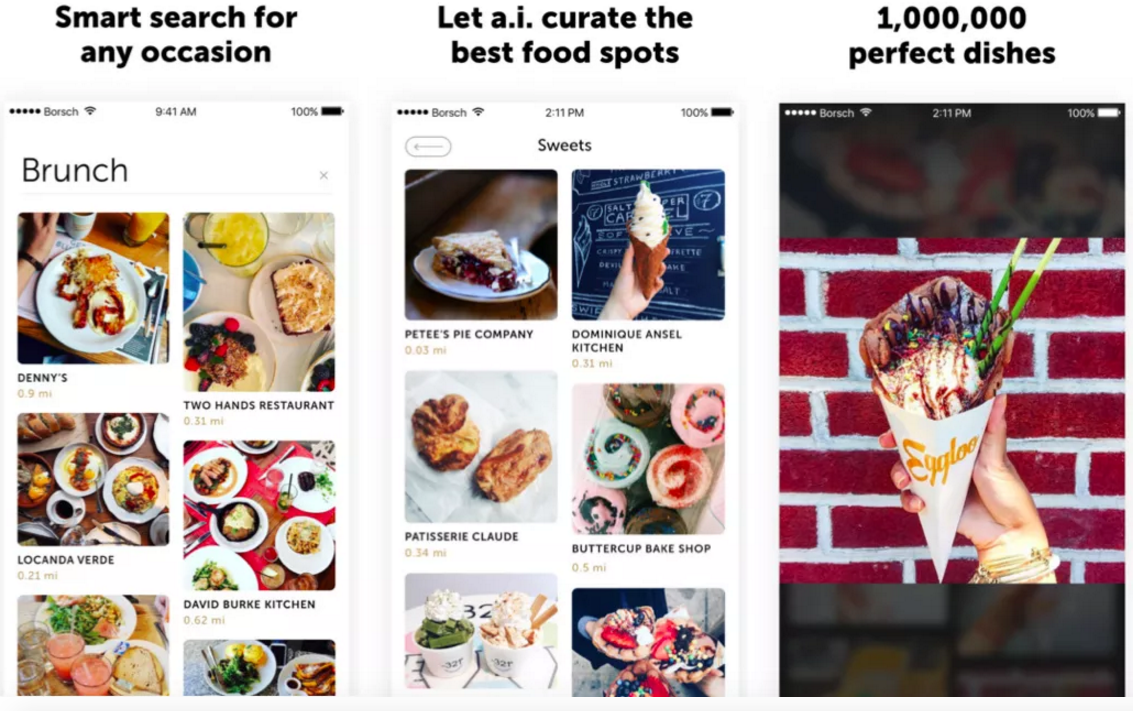
Type in the name of the desired dish, or click one of the photos showing burgers, steaks, omelets, or sushi. Under each photo is a restaurant's name and its distance from you.
Vostock-Photo"I'd like to eat…" With these words the Borsch app greets users. Then you type in the name of the desired dish, or click one of the photos showing burgers, steaks, omelets, or sushi. Under each photo is a restaurant's name and its distance from you.
The app became available in August to residents of New York City, Los Angeles, San Francisco, Austin, Houston, Chicago, Berlin and Moscow. According to the Borsch team, urban dwellers have similar food tastes. At the top of the dining pyramid are burgers, pizza, and popular national dishes depending on the country.
 In the Spot of the Day section the app suggests cafes and restaurants that it considers the most delicious, while in Trending Now you can find places where users are posting photos of dishes in real time. Source: Press photo
In the Spot of the Day section the app suggests cafes and restaurants that it considers the most delicious, while in Trending Now you can find places where users are posting photos of dishes in real time. Source: Press photo
In the Spot of the Day section the app suggests cafes and restaurants that it considers the most delicious, while in Trending Now you can find places where users are posting photos of dishes in real time. By the end of September, with the help of neural networks, Borsch processed more than 12 million photographs.
"We wanted to come up with a name that would make people ask, "Why this?"" said Ashot Gabrelyanov, the startup's founder.
The app's team conducted a study, and they found that the name "Borsch" is mostly associated with a dish from Eastern Europe. Indeed, this is true -- borsch is a soup made of beets and is traditionally served as the first course in Ukraine and Russia. The founders liked the results of the study; the name sounded atypical and easy to remember.
Borsch users can make photographs of their food, and the app automatically determines the most popular dishes with the help of neural networks, and prevents photographs from being uploaded where there is no food.
"I found a good burger joint, even though I previously thought they don't make good food there," said Vitaly, a programmer and Borsch user. From the outside the place looks like a dive but I saw a photo of their burger and decided to try it. Not bad at all."
 "We wanted to come up with a name that would make people ask, 'Why this?'' said Ashot Gabrelyanov, the startup's founder. Source: Press photo
"We wanted to come up with a name that would make people ask, 'Why this?'' said Ashot Gabrelyanov, the startup's founder. Source: Press photo
Borsch does not have a ranking system for food. The team believes that everyone has different tastes; food should not be commented on, and just shown. Currently, the startup's developers are working on a personal assistant that will communicate with users through pictures and videos.
"The Borsch team is making another product," said Nikolai Davydov, a partner at Gagarin Capital investment company. "This will be an exciting service both for the Russian and Western markets."
Gabrelyanov and his team also invented technology to identify content for another project – the Babo user video platform. This startup helps editorial offices of news publications receive multimedia content from the general public. Many video recordings that were difficult to process were then sent through the Babo application.
Users who send content from a location where something occurred often do not describe the situation, and usually only comment with the words, "Ohhh, it's on fire!" That is why the content search should be made with a neural network.
Developing technology for food was far easier, however, which is why the team decided to create the new project based on a neural network. Babo does not yet utilize a neural network, and it is still being tested, explained Gabrelyanov.
In the future Borsch plans to enter the health food market. In the app's latest version you can count the number of calories per 100 grams of food. Also, Borsch's developers want to help those with diabetes to know an item's insulin level.
All rights reserved by Rossiyskaya Gazeta.
Subscribe
to our newsletter!
Get the week's best stories straight to your inbox